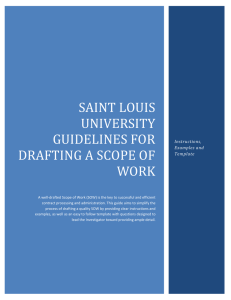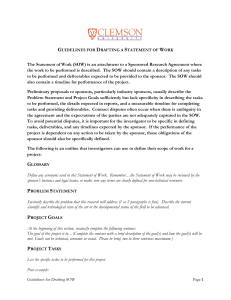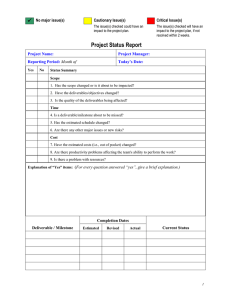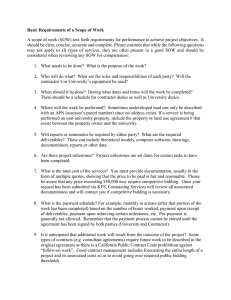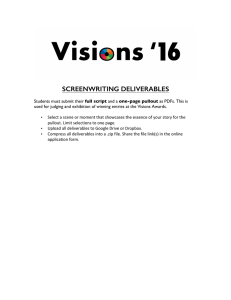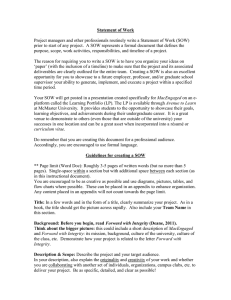Saint Louis University Guidelines for Drafting a Scope of Work
advertisement
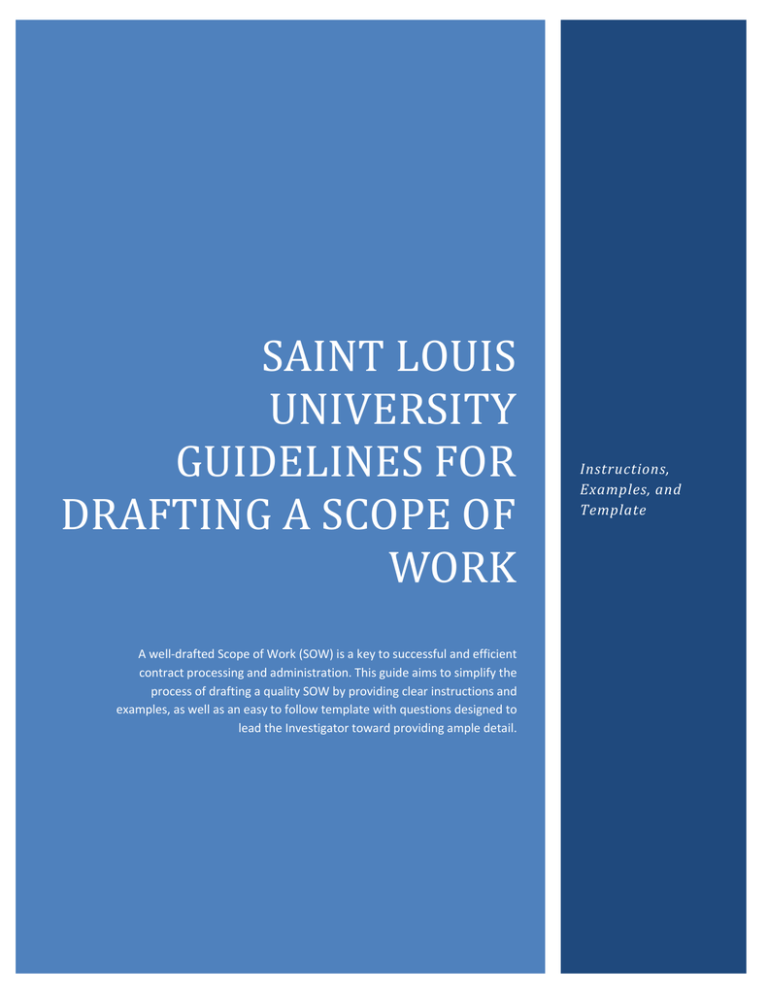
SAINT LOUIS UNIVERSITY GUIDELINES FOR DRAFTING A SCOPE OF WORK A well-drafted Scope of Work (SOW) is a key to successful and efficient contract processing and administration. This guide aims to simplify the process of drafting a quality SOW by providing clear instructions and examples, as well as an easy to follow template with questions designed to lead the Investigator toward providing ample detail. Instructions, Examples, and Template Contents Saint Louis University Instructions for Drafting a Scope of Work ................................................................. 2 I. Glossary………………………………………………………………………………………………………………………………….2 II. Problem Statement…………………………………………………………………………………………………………………….2 III. Deliverables……………………………………………………………………………………………………………………………….2 IV. Administration……………………………………………………………………………………………………………………….3 V. Timeline……………………………………………………………………………………………………………………………………..4 Saint Louis University Scope of Work Template ........................................................................................... 0 I. Glossary: Please define all abbreviations, acronyms and terms of art………………………………………...0 II. Problem Statement: In 1-2 sentences, please describe why this work is necessary…..………………..0 III. Deliverables: Please carefully answer the following questions (and any others which provide additional detail regarding your work) for each Deliverable…………………………………………………………….0 IV. Administration: Please list all requirements that are not an end product of a specific task (e.g. meetings, reports, conferences, etc.)……………………………………………………………………………………………….0 V. Timeline: Please list all due dates associated with the work……………………………………………………….0 Saint Louis University Instructions for Drafting a Scope of Work The Scope of Work (SOW) describes in detail the work to be performed. It is comprised of five parts: 1. 2. 3. 4. 5. Glossary Problem Statement Deliverables Administration Timeline Detailed deliverables are the hallmark of a well drafted SOW. Detailed deliverables answer the questions who, what, when, where, and how. Detailed deliverables avoid ambiguity and are understandable, especially to a non-scientist. This document provides a template for structuring your SOW as well as helpful examples of both wellwritten and ambiguous SOW sections. Please use these as instructional guidelines when drafting your SOW. I. Glossary List and define each abbreviation, acronym or term with a specialized meaning in the field used in the SOW. Be thorough. Please think about this from the perspective of someone who does not work in this particular industry or discipline. II. Problem Statement In one or two paragraphs, describe the problem that this research will address. This section should be brief. For the SOW, what you are doing is more important than why you are doing it. III. Deliverables This is the most important part of the SOW and should command the majority of your time and attention. Please follow this formula: Deliverable = Task + End Product Tasks answer the questions, “What do you want to see happen? What is the goal? How will the goal be achieved?” End Products answer the questions, “What tangible proof will demonstrate that the Task is complete? By what date must the Task be completed?” Be precise. The more precise you are regarding the “what” and “how” of your goals, the more likely they are to be met. Use active voice and task-oriented statements: Active voice (e.g. “The other party SHALL/MUST provide ‘X’”) promotes clarity. Ambiguous Example: Task: Perform [animal] experiment to see if we can improve learning potential. End Product: A table of results. The problem with the above example is that nothing is specified. The task should contain measurable outcomes and the deliverables must be quantifiable. Well-Drafted Example: Deliverable #1: Effect of Substance X on Learning Potential Task: What do you want to see happen? What is the goal? How will the goal be acheived? This study aims to evaluate the effect of [substance X] on the learning potential of [type of animal population]. Utilizing three groups (10 animals per group) of [type of animal population], SLU PI will orally administer [y] mg of [substance X] to Group 1 and [z] mg of [substance X] to Group 2. Group 3 will serve as the control. Over [x] weeks, SLU PI will train [type of animal population] to operate one of two foot pedals to receive a reward. SLU PI will then electrify one of the foot pedals and measure the number of attempts it takes the [type of animal population] to avoid the electrified pedal. End Product: What tangible proof will demonstrate that the Task is complete? By what date must the Task be completed? SLU PI will create a spreadsheet to log the success rate data for each group and will analyze the data to determine if [substance X] had any effect on learning potential. The experiment will be complete by [date]. By reading the Deliverables list, administrative personnel should be able to anticipate the budget. There should be no question about what is expected for each Deliverable. In the template, I have included fields for three deliverables. Please copy and paste a field if your project requires more than three deliverables. Likewise, feel free to delete a field if your project requires less than three deliverables. IV. Administration List any meetings, reports, conferences, or other “soft” deliverables. Describe any requirement that is not an end product of a specific task, but is required of the performing party. Ambiguous Example: PI will be required to give weekly reports of progress during the tornado season with more frequent reports during the height of the season. This example does not specify what needs to be in the reports, what “more frequent” means, or when the “height of the season” occurs. Well-Drafted Example: PI will give weekly written reports consisting of: wind pattern analysis, temperature and precipitation distribution, and potential risk areas. During the typical height of the season, May 15-July 15, the PI may be required to give bi-weekly reports. V. Timeline List all the dates for the project, including completion dates for the tasks, deliverables and administrative tasks. List due dates for written reports, oral progress reports, other service deadlines, or any other item with a due date. FINAL THOUGHTS Between the Glossary, Problem Statement, Deliverables, Administration, and Timeline components of the SOW there should be no ambiguity as to what is expected of the performing party. Please take care to draft the SOW with the layperson in mind. Should there be any disagreement regarding the requirements of the SOW, the SOW will be reviewed and interpreted by someone less scientifically sophisticated than you are! Draft such that it is easy for a layperson to agree with your interpretation. Saint Louis University Scope of Work Template I. Glossary: Please define all abbreviations, acronyms and terms of art. Click here to enter text. II. Problem Statement: In 1-2 sentences, please describe why this work is necessary. Click here to enter text. III. Deliverables: Please carefully answer the following questions (and any others which provide additional detail regarding your work) for each Deliverable. Deliverable #1: Click here to enter text. Task: What do you want to see happen? What is the goal? How will the goal be achieved? Click here to enter text. End Product: What tangible proof will demonstrate that the Task is complete? By what date must the Task be completed? Click here to enter text. Deliverable #2: Click here to enter text. Task: What do you want to see happen? What is the goal? How will the goal be achieved? Click here to enter text. End Product: What tangible proof will demonstrate that the Task is complete? By what date must the Task be completed? Click here to enter text. Deliverable #3: Click here to enter text. Task: What do you want to see happen? What is the goal? How will the goal be achieved? Click here to enter text. End Product: What tangible proof will demonstrate that the Task is complete? By what date must the Task be completed? Click here to enter text. IV. Administration: Please list all requirements that are not an end product of a specific task (e.g. meetings, reports, conferences, etc.) Click here to enter text. V. Timeline: Please list all due dates associated with the work. Click here to enter text. Does this work require SLU: Institutional Animal Care and Use Committee (IACUC) review: ☐ Yes ☐ No Institutional Review Board (IRB) review: ☐ Yes ☐ No Financial Conflict of Interest in Research (COI) review: ☐ Yes ☐ No Institutional Biosafety Committee (IBC) review: ☐ Yes ☐ No
